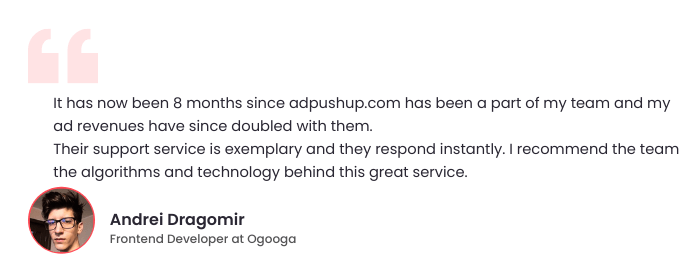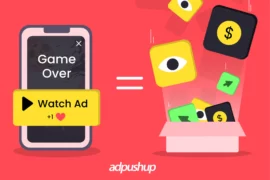Have you been pondering on the idea of video ad serving lately? If yes, you’ve made it to the right blog. In this blog, we’ll be delving into the nitty-gritty of serving video ads so that you can kick-start your video ads strategy fast.
In the bustling digital landscape, where attention is a prized possession, video ads have emerged as the shining beacons of captivating content. If you’re a publisher, harnessing the power of video ads on your website, you can elevate your revenue significantly. Not sure if that’s true?
A study conducted by Statista revealed the expenditure on video ads will make it to a whopping $120 billion by 2024. The figure was about 80 billion in 2021. This shows expenditure on video ads is only increasing and it’s high time publishers should start opting for video ads serving.
However, it’s not so easy to do so. Fear not, for this essential guide is your map through the world of video ad serving, crafted to empower you with the knowledge and expertise needed to unlock the true potential of your website.
What is Video Ad Serving?
Video ad serving is a vital process in digital advertising. It enables publishers to display video advertisements on their websites or apps to targeted audiences. It involves using specialized ad-serving platforms to manage the delivery and display of web video ads.
As a publisher, you provide ad space within your website or app where video ads can be shown. Advertisers, on the other hand, bid for this ad space, and the highest bidder’s video ad gets selected for display.
How Video Ad Serving Works?
When a user visits your website or app, the ad server sends a request for a relevant video ad based on the targeting criteria set by the advertiser. The ad server then selects and delivers the most suitable video ad to the user’s device, where it is displayed within your platform’s video player.
The goal of video ad serving is to optimize the ad placement and targeting to ensure that the right video ads are shown to the right audience at the right time. This not only benefits the advertiser by reaching their desired audience effectively but also benefits you as a publisher by maximizing your ad revenue potential.
What are the Video Ad Serving Types?
Now that you have decided to serve video ads, it’s time to learn what all are video ads for websites available. Here are two ways you can advertise:

Instream Ads
Instream ads are video advertisements that are integrated seamlessly within the video content that users are actively consuming. These ads typically appear before, during, or after the main video and are non-skippable or skippable after a few seconds.
Non-skippable instream ads require users to watch the entire ad before proceeding to the main video, while skippable ones allow viewers to skip the ad after a specified duration. Instream ads are highly effective for capturing viewers’ attention and are commonly used on platforms like YouTube and other video streaming services.
Outstream Ads
Another type of video ads for website is Outstream ads, which is also known as in-read or native video ads. These video advertisements do not rely on existing video content for placement. Unlike in-stream ads, out-stream ads are typically displayed within text-based articles or on static web pages. When a user scrolls through the content, the out-stream ad automatically starts playing, often on mute, to avoid disrupting the user experience.
These ads offer publishers additional opportunities for monetization as they don’t require embedded video players and can be displayed on various devices, including mobile phones and tablets.
Moreover, Google’s push for Outstream video ads is likely to lead to a surge in outstream video advertising, making it a great option for publishers to try this ad format.
Companion Display Ads
Companion display ads, also known as banner or overlay ads, accompany the video player during the playback of instream video ads. They appear either above, below, or on the sides of the video player and can include static images, interactive elements, or text. Companion display ads complement the main video ad, providing additional information, calls-to-action, or branding opportunities for advertisers. These ads enhance engagement and can direct users to the advertiser’s website or other related content.
Serve Pre-Roll, Mid-Roll, or Post-Roll Video Ads
Like most publishers, you might be in a dilemma about where to get started with the video ad serving to get the best results. Here are three options.
Pre-Roll Ads
This one is an oldie. It appears before the main content starts playing.
For a long period, this was the go-to method because the audience, eager to watch the content, will be willing to consume the advertisement.
No, pre-roll ads don’t disrupt the viewing experience. According to an IPG Media Lap study, only 17% considered pre-roll as an interruption.
Mid-Roll Ads
It’s a good idea to use the mid-roll ads if you’re planning to share the videos on Facebook.
If the video content is engaging, a CMG Local Solutions study shows the completion rate of mid-roll ads to be higher than pre-roll and post-roll ads.
Post-Roll Ads
Some doubt the performance of video ads that appear after the main content.
Well, post-roll ads perform best in specific circumstances. These ads are best suited to place a call to action following the content.
How to Get Started with Video Ad Serving?
1. Sign up for Relevant Video Ad Networks
First step to begin with the video ad serving efforts is to sign up for relevant video ad networks. Businesses realize that a few seconds of high-quality, creative video content can attract and engage the audience.
It isn’t surprising that each year billions of dollars are spent on video advertisements. A small fraction of that money can be yours.
The hard part is already done. You have in place a website with quality videos. The next obvious step is to decide what ad to show, how and whom to approach, etc.
Joining a video ad network is the right thing to do if you want to make a decent additional income.
Video ad networks provide a vital service. They connect the advertisers with you (the person providing the advertising space). Finding video ad networks won’t be hard. You can find a handful of services within seconds of browsing the internet.
That said, start with a name you can trust.
For first-time publishers, the Google Ad Manager and Marketing Platform will be the best place to start.
The Google platform offers the best tools and features such as real-time bidding for you to monetize your content.
2. Buy a Subscription for the Right Video Player
You need a tool to display all the videos on your server or computer.
Earlier, the choice was between Flash and HTML video players. Well, ask anyone, flash is gone and you’re left with HTML5.
Those wanting to earn money from content must select their video player with due diligence.
You need a video player that has a fast load time, comes with cross-browser compatibility, and works exceptionally well on mobile devices.
Furthermore, the player must be easy to customize and require very little maintenance.
JW Player and Radiant Media Player are just two of the many popular web and mobile video players.
Bear in mind, that you’ll have to subscribe to a premium monthly plan to use the player.
3. Set up Your Website for Video Ad Display
It wouldn’t make sense to subscribe to a video player and join a video ad network without a website. You need a place to publish the ads; you need a website.
Evan a landing page would do; there are several landing page builder tools to help you accomplish this task.
Once the website or video landing page is ready, ensure it is optimized.
The ad publishing website must also comply with the eligibility requirements of the ad network.
Although every ad network has its own set of rules, there are commonalities between them.
Your website must be easy to navigate and contain no broken links or elements. The portal must be well-designed and contain text that’s easy to read.
Advertisers don’t want their brand associated with certain niches.
This includes websites that promote illegal activities, tobacco, alcohol, weapons, hateful content, malware, nudity, excessive profanity, etc. Stay away from these niches.
4. Select Videos to Start Displaying Ads In
The next step for effective video ad serving is selecting the right videos. Video content that attracts the maximum eyeballs will make the most money for you.
You may have a huge array of videos, but consider using only those that will garner a large viewership.
It’s possible to make any niche interesting. Nowadays, creative content that’s presented engagingly and entertainingly attracts views.
The animated explainer video, review video, and how-to video content are some of the most searched terms on YouTube.
Consider adding influencer videos to the mix. It is the right YouTube Influencer marketing approach to promote your business.
On social media, many influencers command a huge following. They can very well become your potential video ad viewers.
You can approach influencer marketing agencies to find the right influencers for your videos.
5. Monitor Your Performance
The real tough task begins only after integrating the video ad into the content. Maximize video potential by developing a strong marketing plan.
With the aid of content marketing tools, you can market the website, text, and video content. Alternatively, you can hire a digital agency to take care of the marketing.
The success of the entire video monetization process depends on how well you monitor their performance.
By analyzing the key performance metrics such as viewership, CTR, etc, you can identify weak areas that need your attention.
You’ll rarely hit up a winning formula right at the beginning. Only through constant performance audits, customization, and optimization that you can expect good results.
Final Thoughts
That’s it. This article should serve as a good reference and help you get started with video ad serving earn money through video ads.
With these simple steps, you can get the video ad monetization process off the ground.
FAQs – Video Ad Serving
Video ad serving, in simple words, is the process of delivering video advertisements to targeted audiences on websites and apps.
A video ad server is a specialized platform that manages and distributes video ads to websites and apps, ensuring they reach the right audience at the right time.
Video ad serving works by advertisers bidding for ad space on websites or apps, with the highest bidder’s video ad being displayed to users based on targeting criteria.
The 5 types of video ads are: Instream ads (within video content), Outstream ads (outside video content), Companion Display ads (accompanying video ads), and In-Display ads (on video search result pages).

Deepak has a keen eye for detail and a deep understanding of the ad tech landscape. Whether it’s through in-depth articles, thought-provoking insights, or compelling storytelling, he’s dedicated to helping people navigate the complex world of ad tech with the simplicity of his words.







